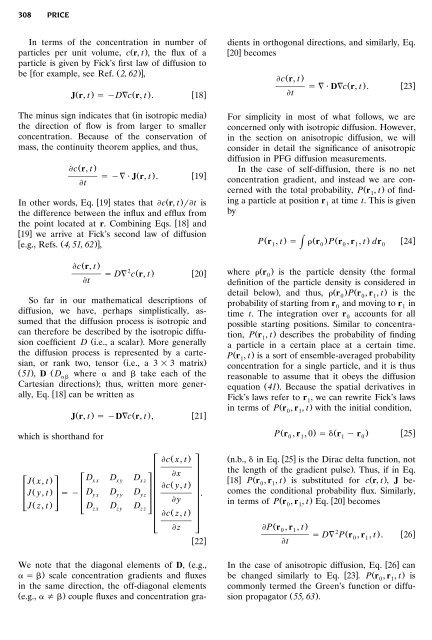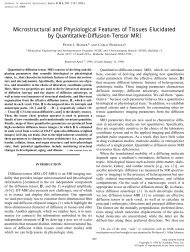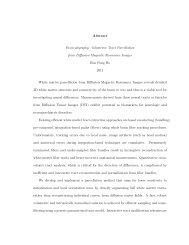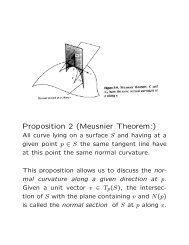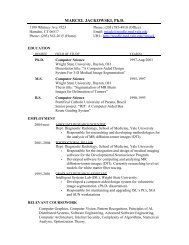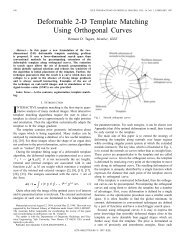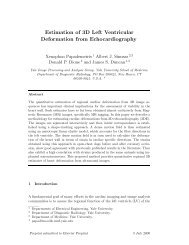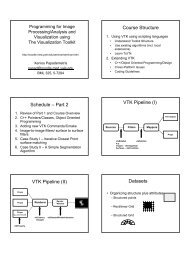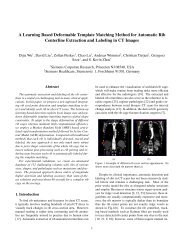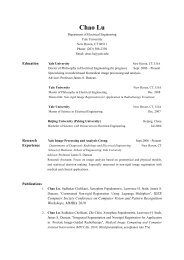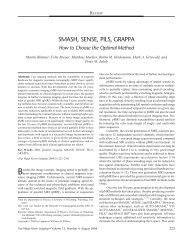Pulsed-field gradient nuclear magnetic resonance as a tool for ...
Pulsed-field gradient nuclear magnetic resonance as a tool for ...
Pulsed-field gradient nuclear magnetic resonance as a tool for ...
Create successful ePaper yourself
Turn your PDF publications into a flip-book with our unique Google optimized e-Paper software.
308<br />
PRICE<br />
In terms of the concentration in number of<br />
particles per unit volume, cŽ r, t . , the flux of a<br />
particle is given by Fick’s first law of diffusion to<br />
be <strong>for</strong> example, see Ref. Ž 2, 62 .,<br />
Ž . Ž . <br />
Jr,t Dc r,t . 18<br />
Ž .<br />
The minus sign indicates that in isotropic media<br />
the direction of flow is from larger to smaller<br />
concentration. Because of the conservation of<br />
m<strong>as</strong>s, the continuity theorem applies, and thus,<br />
Ž .<br />
c r,t<br />
t<br />
Ž . <br />
Jr,t . 19<br />
In other words, Eq. 19 states that cŽ r, t. t is<br />
the difference between the influx and efflux from<br />
the point located at r. Combining Eqs. 18 and<br />
19 we arrive at Fick’s second law of diffusion<br />
e.g., Refs. Ž 4, 51, 62 .,<br />
Ž .<br />
c r,t<br />
t<br />
2 Ž . <br />
D c r,t 20<br />
So far in our mathematical descriptions of<br />
diffusion, we have, perhaps simplistically, <strong>as</strong>sumed<br />
that the diffusion process is isotropic and<br />
can there<strong>for</strong>e be described by the isotropic diffusion<br />
coefficient D Ž i.e., a scalar . . More generally<br />
the diffusion process is represented by a cartesian,<br />
or rank two, tensor Ž i.e., a 3 3 matrix.<br />
Ž 51 . , D ŽD<br />
where and take each of the<br />
Cartesian directions . ; thus, written more generally,<br />
Eq. 18 can be written <strong>as</strong><br />
which is shorthand <strong>for</strong><br />
Ž . Ž . <br />
Jr,t Dc r,t , 21<br />
Ž .<br />
c x,t<br />
D D D<br />
x<br />
JŽ x,t. xx xy xz<br />
cŽ y,t.<br />
JŽ y,t. Dyx DyyDyz .<br />
y<br />
JŽ z,t. Dzx Dzy Dzz<br />
cŽ z,t.<br />
z<br />
<br />
22<br />
We note that the diagonal elements of D, Že.g.,<br />
. scale concentration <strong>gradient</strong>s and fluxes<br />
in the same direction, the off-diagonal elements<br />
Ž e.g., . couple fluxes and concentration gra-<br />
dients in orthogonal directions, and similarly, Eq.<br />
<br />
20 becomes<br />
Ž .<br />
c r,t<br />
t<br />
Ž . <br />
Dc r,t . 23<br />
For simplicity in most of what follows, we are<br />
concerned only with isotropic diffusion. However,<br />
in the section on anisotropic diffusion, we will<br />
consider in detail the significance of anisotropic<br />
diffusion in PFG diffusion me<strong>as</strong>urements.<br />
In the c<strong>as</strong>e of self-diffusion, there is no net<br />
concentration <strong>gradient</strong>, and instead we are concerned<br />
with the total probability, PŽ r , t. 1 of finding<br />
a particle at position r1 at time t. This is given<br />
by<br />
H<br />
PŽ r ,t. Ž r . PŽ r ,r ,t. dr 24 1 0 0 1 0<br />
where Ž r . is the particle density Ž<br />
0<br />
the <strong>for</strong>mal<br />
definition of the particle density is considered in<br />
detail below . , and thus, Ž r . PŽ r , r , t. 0 0 1 is the<br />
probability of starting from r 0 and moving to r1 in<br />
time t. The integration over r 0 accounts <strong>for</strong> all<br />
possible starting positions. Similar to concentration,<br />
PŽ r , t. 1 describes the probability of finding<br />
a particle in a certain place at a certain time.<br />
PŽ r ,t. 1 is a sort of ensemble-averaged probability<br />
concentration <strong>for</strong> a single particle, and it is thus<br />
re<strong>as</strong>onable to <strong>as</strong>sume that it obeys the diffusion<br />
equation Ž 41 . . Because the spatial derivatives in<br />
Fick’s laws refer to r 1,<br />
we can rewrite Fick’s laws<br />
in terms of PŽ r , r , t. with the initial condition,<br />
0 1<br />
Ž . Ž . <br />
P r ,r ,0 r r 25<br />
0 1 1 0<br />
Žn.b., in Eq. 25 is the Dirac delta function, not<br />
the length of the <strong>gradient</strong> pulse . . Thus, if in Eq.<br />
18 PŽ r , r , t. is substituted <strong>for</strong> cŽ r, t .<br />
0 1<br />
, J becomes<br />
the conditional probability flux. Similarly,<br />
in terms of PŽ r , r , t. Eq. 20 becomes<br />
0 1<br />
PŽ r ,r ,t.<br />
0 1 2 D PŽ r ,r ,t . . 26 0 1<br />
t<br />
In the c<strong>as</strong>e of anisotropic diffusion, Eq. 26 can<br />
be changed similarly to Eq. 23 . PŽ r , r , t. 0 1 is<br />
commonly termed the Green’s function or diffusion<br />
propagator Ž 55, 63 . .


